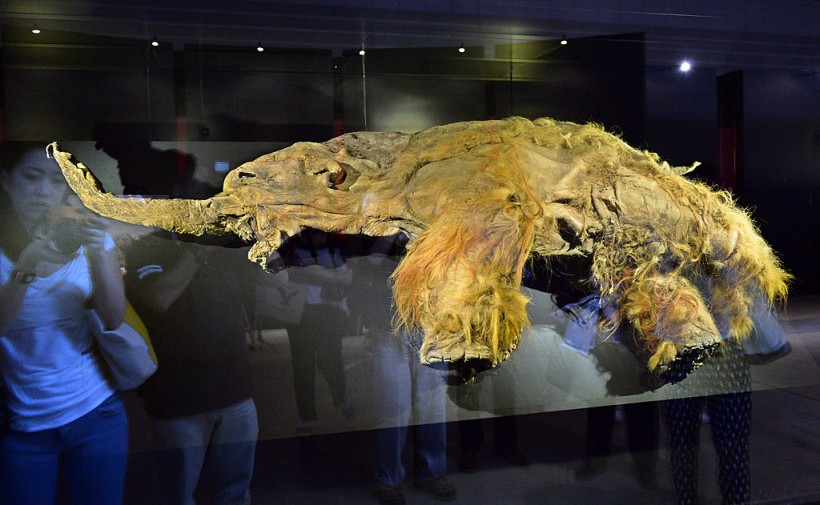Researchers decoded the genetic material of woolly mammoths taken from their tusks, including a tusk that dates back to 18,000 years ago. These ancient mammals were warm, but they became warmer over the years.
The study, titled "Genomics of Adaptive Evolution in the Woolly Mammoth" published in the journal Current Biology, reports that the characteristics that made woolly mammoths distinctive, such as their thick fur, became even more pronounced during the 700,000 years they lived in Siberia, with the final woolly mammoths being the warmest.

The frozen carcass of a 39,000-year-old female woolly mammoth named Yuka from the Siberian permafrost is displayed for an exhibition in Yokohama, suburban Tokyo on July 12, 2013 at a press preview before the opening.
Comparing Woolly Mammoth Genomes to Modern Elephants
The study used genome sequencing to investigate the evolution of woolly mammoths, comparing the genomes of modern elephants to 23 woolly mammoths from Siberia, Science Alert reported. Researchers identified the genetic mutations that were unique to woolly mammoths and led to their distinctive features, such as fluffier fur and small ears.
The research showed that these features were already genetically encoded in early woolly mammoths but grew more pronounced as the animals adapted to the harsh conditions of Siberia over hundreds of thousands of years.
The Pleistocene Epoch saw the existence of various mammoth species, descendants of the earlier African mammoth that migrated out of Africa. Eurasia was home to the steppe mammoth, a likely ancestor of the woolly mammoth, which first appeared about 700,000 years ago in Asia. Woolly mammoths thrived in the chilly conditions of their time, expanding into Europe and North America.
The study is the first to compare the genomes of a large sample size of mammoths, including many fairly modern specimens, and the oldest known mammoth genome. Researchers said in a press release that this allowed them to identify genetic mutations that were common among mammoths, and therefore adaptive, rather than quirks that might have arisen in a few individuals.
By examining so many genomes, the study identified genes that were previously thought to be unique to woolly mammoths. The study offers insight into how woolly mammoths adapted to their environment over time and how they diverged from steppe mammoths.
The Chukochya genome, from the oldest known mammoth specimen, shared 91.7% of the mutations responsible for protein-coding changes seen in more recent woolly mammoths, suggesting that early woolly mammoths already had some distinctive traits when they diverged from steppe mammoths.
Woolly Mammoth Evolution Was Not Yet Complete
Researchers noted that the first woolly mammoths may have possessed characteristics that were still developing and may have looked differently from their descendants, despite being woolly and potentially having other abilities for which their species would later become known.
They suggest that the early mammoths may have had larger ears and less insulating and fluffy wool compared to later woolly mammoths, Discover reported. However, the evolution of fluffier fur was likely advantageous in ice-age Siberia, as it provided insulation in the frigid environment. In addition, other qualities, such as smaller ears, were likely refined over time to reduce heat loss.
In other words, the findings demonstrated that the wool of the woolly mammoth was present from the beginning of their species, but it gradually became more noticeable and widespread over time, which enhanced the suitability of the mammoth to live in cold and icy environments.
RELATED ARTICLE: 7-Foot Long Woolly Mammoth Tusk Examined via a New Clinical CT Scanner; What Did the Researchers Discover?
Check out more news and information on Paleontology in Science Times.














